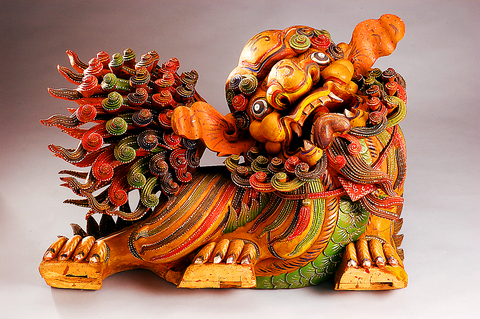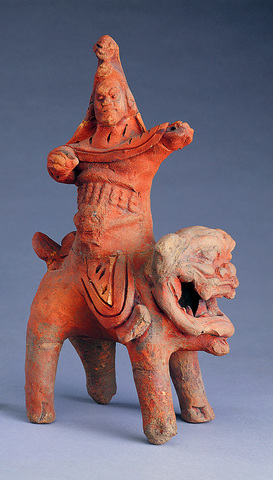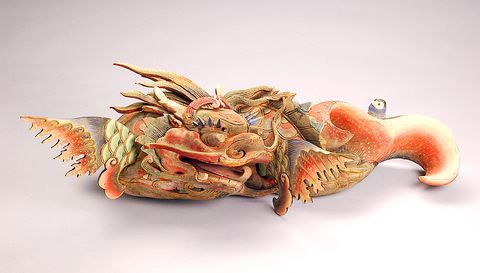It is said that most Taiwanese practice a mixture of Buddhism, Taoism and folk beliefs. But what are these folk beliefs and how are they
practiced?
Taiwanese folk religion is centered on the concepts of attracting good fortune and repelling ill fortune. Pursuing Good Fortune -- Taiwanese Folk Cultural Artefacts, the new special exhibition at the Museum of World Religions in Yonghe (

The entryway to the exhibition is narrow and crooked and co-vered with floor-to-ceiling pictures of brick walls and curving Chinese roofs. It gives you the sense of walking through the narrow alleyways of a small town somewhere in Taiwan.
The first section of the exhibition is dedicated to "spaces" and contains a temple display and a residential display. The representation of a traditional Taiwanese temple is much simplified yet unmistakable: Imposing, angry-looking painted generals stand guard on either side of the door; stylized mythical beasts sit atop beams and pillars; and the altar inside is illuminated with red light.
Special attention is given to the beasts in this section of the exhibition. The sculptures of phoenixes, dragons and lions all have their specific duties of protecting the temple. For example, a dragon-fish beast called the aoyu (

Some of the more humorous items in the residential display are the clay "wind lions" (
The section on personal items contained mostly pendants worn to ward off evil spirits, including the donut-shaped coin pendants that are still popular today.
Some of the exhibition's most beautiful items were the ceremonial baby clothes in the stages-of-life section. The little caps adorned with embroidered mythical beasts were especially

adorable.
As informative as the exhibition is, non-Chinese-reading visitors should bring a Taiwanese friend along with them to
translate, as the artefacts' descriptions are in Chinese only.
The NT$150 ticket for admission gets you into the rest of the museum, which contains some lovely displays, such as intricate models of major world temples. To get to the museum, take the Nanshijiao MRT line to Dingxi Station and wait for the free Sogo shuttle outside Exit 1. The museum is in the same building as Sogo.
Exhibition notes
What: Pursuing Good Fortune ? Taiwanese Folk Cultural Artefacts(
Where: Museum of World Religions, 7F, 236 Zhongshan Rd, Yonghe, Taipei (
Telephone: (02) 8231 5966
When: To Feb. 10, 2006

On April 26, The Lancet published a letter from two doctors at Taichung-based China Medical University Hospital (CMUH) warning that “Taiwan’s Health Care System is on the Brink of Collapse.” The authors said that “Years of policy inaction and mismanagement of resources have led to the National Health Insurance system operating under unsustainable conditions.” The pushback was immediate. Errors in the paper were quickly identified and publicized, to discredit the authors (the hospital apologized). CNA reported that CMUH said the letter described Taiwan in 2021 as having 62 nurses per 10,000 people, when the correct number was 78 nurses per 10,000

As we live longer, our risk of cognitive impairment is increasing. How can we delay the onset of symptoms? Do we have to give up every indulgence or can small changes make a difference? We asked neurologists for tips on how to keep our brains healthy for life. TAKE CARE OF YOUR HEALTH “All of the sensible things that apply to bodily health apply to brain health,” says Suzanne O’Sullivan, a consultant in neurology at the National Hospital for Neurology and Neurosurgery in London, and the author of The Age of Diagnosis. “When you’re 20, you can get away with absolute

May 5 to May 11 What started out as friction between Taiwanese students at Taichung First High School and a Japanese head cook escalated dramatically over the first two weeks of May 1927. It began on April 30 when the cook’s wife knew that lotus starch used in that night’s dinner had rat feces in it, but failed to inform staff until the meal was already prepared. The students believed that her silence was intentional, and filed a complaint. The school’s Japanese administrators sided with the cook’s family, dismissing the students as troublemakers and clamping down on their freedoms — with

As Donald Trump’s executive order in March led to the shuttering of Voice of America (VOA) — the global broadcaster whose roots date back to the fight against Nazi propaganda — he quickly attracted support from figures not used to aligning themselves with any US administration. Trump had ordered the US Agency for Global Media, the federal agency that funds VOA and other groups promoting independent journalism overseas, to be “eliminated to the maximum extent consistent with applicable law.” The decision suddenly halted programming in 49 languages to more than 425 million people. In Moscow, Margarita Simonyan, the hardline editor-in-chief of the